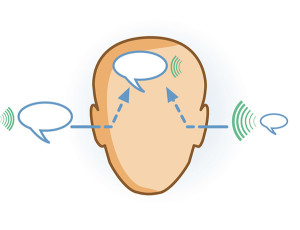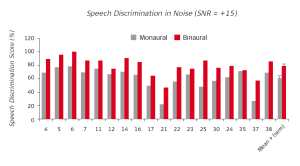MED-EL
Published May 28, 2014
Why You Hear Better With Bilateral Cochlear Implants

If you have only one hearing implant, or have a hearing loss in only one ear, have you ever thought about the benefits that you’d get from hearing with both ears?
There are three main benefits to hearing with both ears, known as binaural hearing. In a previous post I showed how binaural hearing is necessary for sound localization, and now I’d like to talk about another of the big benefits: being able to hear and understand better in noisy situations.
Trying to understand someone speak when there’s lots of background noise is one of the great challenges for any listener, let alone for hearing implant recipients. Cochlear implant sound coding strategies have been developed to make listening in noisy situations easier, but that’s not the only way to listen better. One of the best and clinically-proven ways to get better speech understanding, especially in noise, is by having two implants (or hearing with two ears).
Unfortunately, up to 35% of children who can hear with only one ear will fail more than one grade in school, and will have much poorer speech understanding in noise than their classmates.1
However, there is a solution: two implants. When someone receives two implants, studies prove their listening skills increase. In a study of 39 school-age children, using bilateral cochlear implants was found to increase the understanding of spoken words in general and significantly increase the understanding of speech in noise.
The graph to the right shows the results of that study that measured the ability of 18 recipients to discriminate speech in noise.2
Why is it so difficult to understand speech in noise, especially with only one implant? A main reason is that it’s up to the one audio processor to understand sounds from all directions. This means that if someone can hear with their right ear, this ear will pick up sounds from both the right and left side.
It’s very difficult for the brain to understand from which side the noises come. If someone is speaking to them from the right side, the ear will hear both their speech as well as all the noise from the left side, and the brain will have to try and understand which sounds are most important.
When someone has two implants, and therefore can hear from both sides, the job of each ear is reduced drastically. Now, the person can use one ear to hear sounds from the left side and one ear to hear sounds from the right side. The result is what’s called the “Squelch Effect,” and here’s a little graphic that shows what happens:
Each ear receives a different mix of speech and noise. The brain then knows how much noise or speech came from each side, and by comparing these levels it’s able to filter out the noise and other unwanted sounds. In the end, speech understanding is far easier than would ever be possible with only one implant.
To hear from someone who has chosen to go bilateral, you can watch this video about Joshua, a young boy who received bilateral MED-EL cochlear implants.
If you want to learn about you can getting a second cochlear implant, so that you can hear bilaterally, you can always contact your local MED-EL representative.
References
- Tharpe, A. (2008). Unilateral and mild bilateral hearing loss in children: past and current perspectives. Trends in Amplification, 12 (1), 7-15.
- Kühn-Inacker, H., Shehata-Dieler, W., Müller, J., Helms, J. (2004). Bilateral cochlear implants: a way to optimize auditory perception abilities in deaf children? International Journal of Pediatric Otorhinolaryngology, 68, 1257-1266.
MED-EL
Was this article helpful?
Thanks for your feedback.
Sign up for newsletter below for more.
Thanks for your feedback.
Please leave your message below.
Thanks for your message. We will reply as soon as possible.
Send us a message
Field is required
John Doe
Field is required
name@mail.com
Field is required
What do you think?
© MED-EL Medical Electronics. All rights reserved. The content on this website is for general informational purposes only and should not be taken as medical advice. Contact your doctor or hearing specialist to learn what type of hearing solution suits your specific needs. Not all products, features, or indications are approved in all countries.
MED-EL




